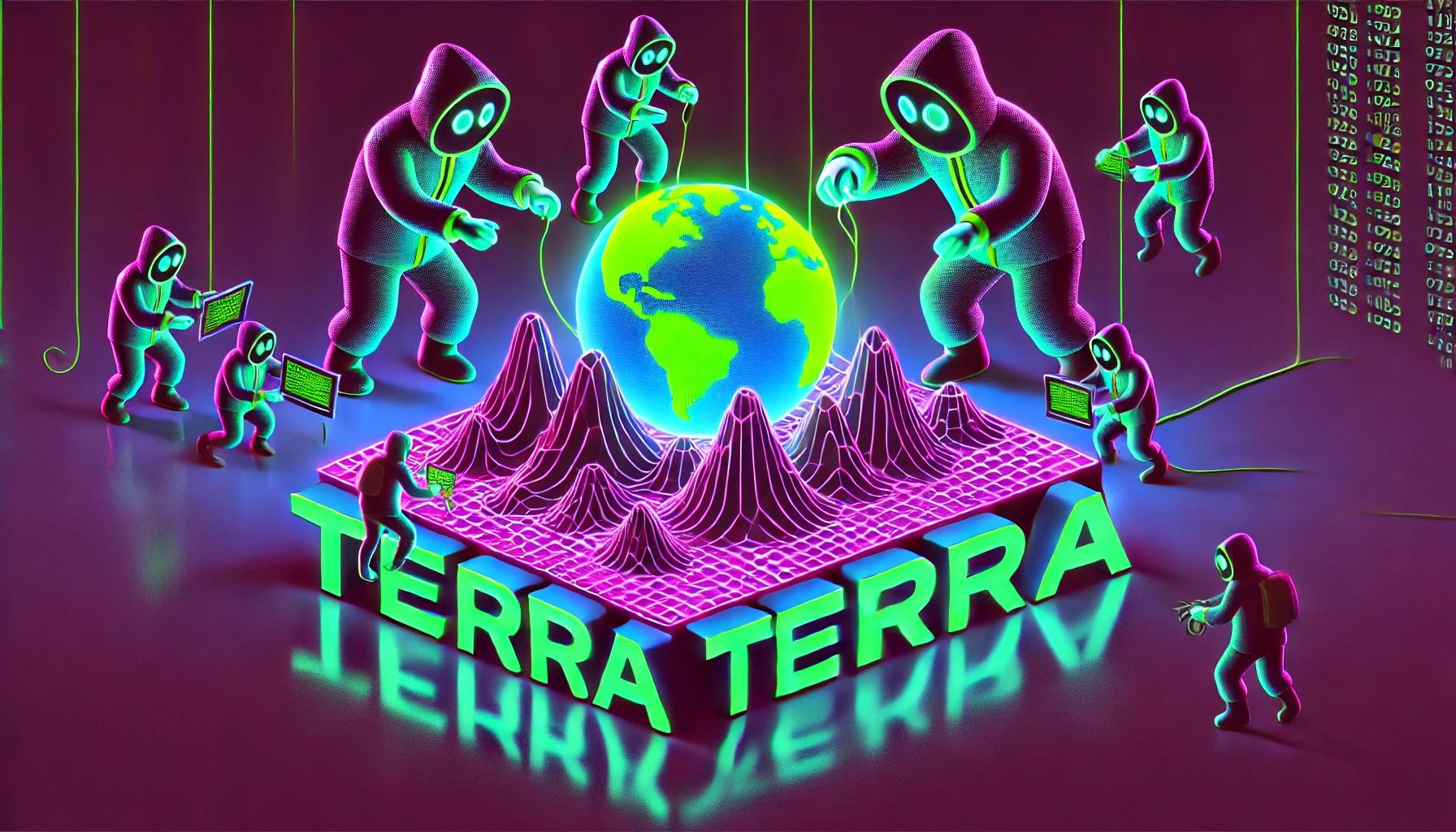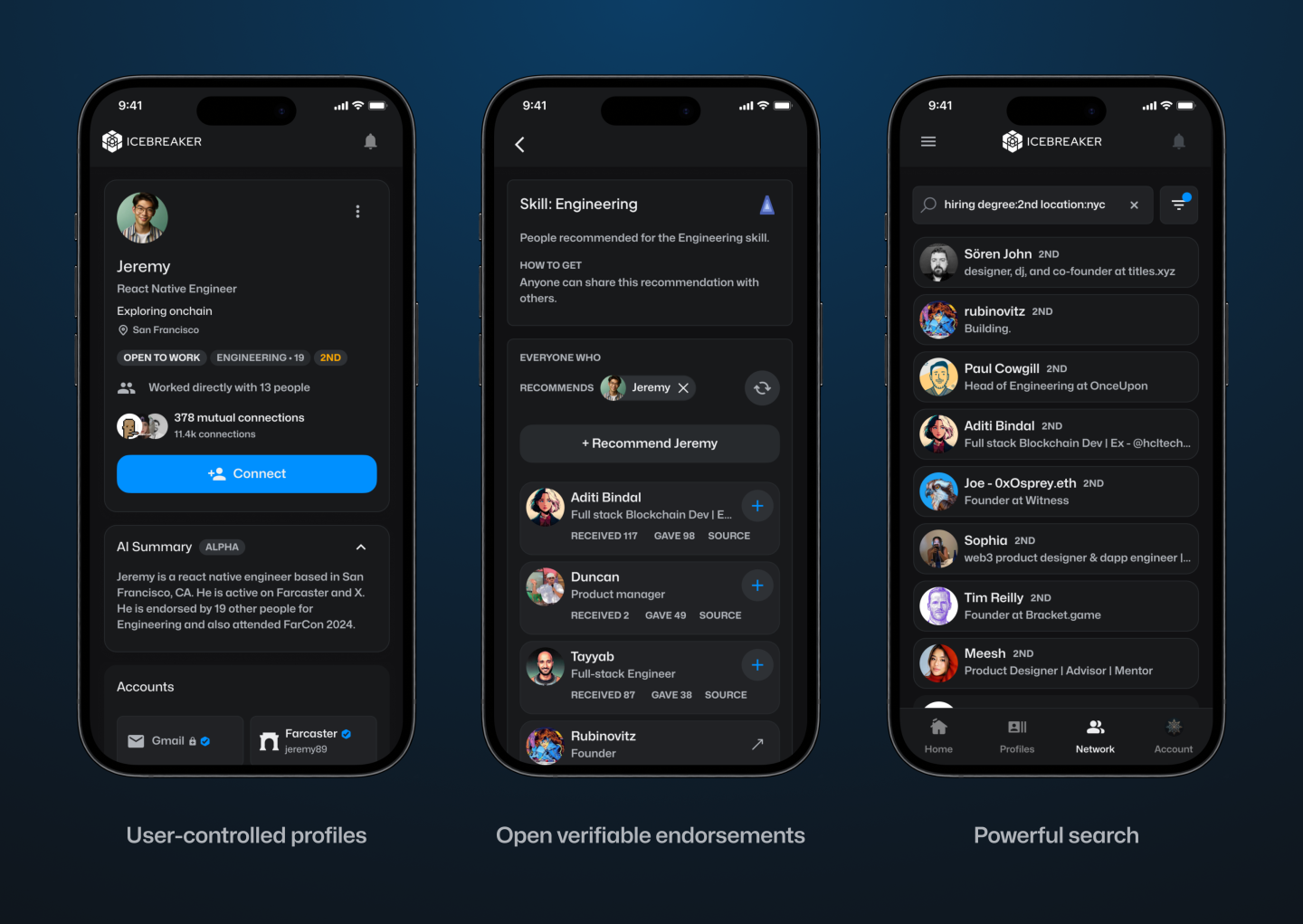News
The Rise Of Crypto’s Billion Dollar Zombies

With bitcoin soaring once again, blockchains are suddenly much more valuable. More than 50 of them are now worth over $1 billion—despite many having few users.
By Steven Ehrlich, Maria Gracia Santillana Linares and Nina Bambysheva, Forbes Staff
In 2012 when Blockchain pioneers Jed McCaleb, Arthur Britto and David Schwartz created Ripple Labs and its new cryptocurrency, known as XRP, they envisioned a new global financial standard that would enable banks to transfer money rapidly with minimal fees. During its first decade, dozens of financial institutions, including Bank of America and Banco Santander, signed up, eager to test Ripple’s new network. To fund their ambitious project, executives at the company created 100 billion XRP tokens and sold $1.4 billion worth to the public. In early 2018, at the height of the first wave of crypto euphoria, XRP was trading with a market value of $132 billion, giving cofounder and executive chairman Chris Larsen a net worth of $8 billion.
In terms of global money flows, not much is going on at Ripple Labs today, and few expect it ever to disrupt the Belgian banking cooperative known as SWIFT, which facilitates $5 trillion in interbank transfers every day. Despite failing at its primary mission, Ripple’s blockchain, a ledger of XRP transactions, continues to hum along. It’s largely useless, but the XRP token still sports a market value of $36 billion, making it the sixth-most valuable cryptocurrency. Larsen remains a billionaire, worth an estimated $3.2 billion. Last year, Ripple’s XRP ledger earned a mere $583,000 in fees processing transactions across its network, according to Messari. In Wall Street parlance, that would give XRP a “price-to-sales” ratio of 61,689. Nvidia, the market’s hottest stock, with a market capitalization above $2 trillion and revenue of $61 billion, has a price-to-sales ratio of 37.
Ripple Labs is a crypto zombie. Its XRP tokens continue to trade actively, some $2 billion worth per day, but to no purpose other than speculation. Not only is SWIFT still going strong, but there are now better ways to send payments internationally via blockchains, especially stablecoins like tether, which is pegged to the U.S. dollar and has $100 billion in circulation.
Ripple is not alone. A Forbes investigation reveals that even though only a handful of blockchains other than Bitcoin and Ethereum have gained significant traction, there are no fewer than 50 blockchains today trading at values of more than $1 billion, of which at least 20 are functional zombies. In the wake of the SEC’s approval of spot bitcoin ETFs, crypto markets are soaring. The 20 blockchains Forbes analyzed, whose quixotic ambitions range from a universal world computer to an untraceable payments network, have a combined market value of $116 billion. Most have few users.
But don’t expect XRP or any of these crypto creations to shutter operations anytime soon. With billions sitting in their coffers, Ripple and others can continue to exist for years. Ripple currently has $24 billion worth of XRP tokens in escrow that it can sell over the next four years. Currently, the San Francisco company has 900 employees and continues to issue press releases for things like its recent acquisition of digital asset custody operation Standard Custody & Trust. After more than a decade in existence, it is still running pilot crypto programs with central banks in places like the nation of Georgia and the South Pacific Republic of Palau.
“It’s like early-stage venture capital funds or companies that raise too much money and don’t know how to adequately deploy it,” says Matt Hougan, CIO of Bitwise Asset Management. “There’s no way to return the treasury to the investors.”
Moreover, in the bizarro world of digital assets, rich zombie blockchains need not worry about the kinds of things that keep traditional companies on their toes. There are no shareholders or regulators asking for financial statements, and short selling tokens is relatively difficult. So long as there is an ample supply of speculators willing to trade the tokens, flush zombie blockchains will continue to roam the digital landscape.
Says one venture capitalist who requested anonymity, “There’s no wind-down process for a dead crypto protocol.”
GOOD-FOR-NOTHING BLOCKCHAINS
The 20 blockchains below command a total market value of more than $100 billion despite the fact that they are unproven and have little utility other than for speculative crypto trading. Most have treasuries brimming with millions, but they answer to neither shareholders nor regulators.
(SCROLL RIGHT TO SEE THE FULL TABLE)
ZOMBIE BLOCKCHAINS mostly fall into two categories: They are either spin-offs of earlier blockchains like Bitcoin and Ethereum or direct competitors to them. Spin-off (a.k.a. “hard fork”) zombies include Bitcoin Cash, Litecoin, Monero, Bitcoin SV and Ethereum Classic. These five blockchains collectively trade at a valuation of $23 billion today. They are largely the result of disagreements between programmers over how Bitcoin or Ethereum should be run. Because the code underlying these blockchains is open source, anyone can repurpose it for any reason. When the coders can’t get along, a group of them will split off and create a new network, a schism known as a hard fork. Each time a new chain is created this way, it shares the same history as the original chain. And like stock spin-offs, this means that all token holders at the time of the fork receive the same number of tokens on the new chain that they own on the original.
Litecoin was an early Bitcoin fork. It launched in 2011 as a faster, cheaper version for sending payments. It produces blocks four times faster than Bitcoin, an average of one every 2.5 minutes against every 10 minutes for Bitcoin. Like Bitcoin, it processes transactions via proof of work, meaning lots of computers are spinning their wheels (and burning electricity) solving pointless mathematical equations. Also like Bitcoin, it has a hard limit on its token supply, 84 million versus Bitcoin’s 21 million. Today Litecoin has a market capitalization of $6.5 billion, but last year it booked just $389,000 in fees, compared to $800 million for Bitcoin. Blockchain users pay fees to miners as an incentive for them to process their transactions in the next block they create. The fees generated by zombie blockchains like Litecoin are minimal, indicating a lack of demand for the platform. These blockchains also have trouble attracting developers. As of the end of 2023 there were only 74 monthly active open-source developers supporting Litecoin, according to Electric Capital’s Developer Report, compared to more than 1,000 for Bitcoin and 7,000-plus for Ethereum.
Bitcoin Cash is worth even more than Litecoin, with a market cap of $7.9 billion, yet it has only 30 monthly active developers supporting it and $49,000 in 2023 fee revenue. Bitcoin Cash was born after an acrimonious split with Bitcoin in 2017 over whether to increase Bitcoin’s block size. The fight was arcane. Essentially, Bitcoin Cash supporters thought the crypto should be primarily useful as a medium of exchange (in other words, you should be able to buy things with it), while the rest of the community wanted to prioritize the store of value function, or the ability to save it for future use.
Bitcoin SV—for “Satoshi Vision”—is even more controversial, given that it’s fronted by Craig Wright, an Australian computer scientist who dubiously claims to be Satoshi Nakamoto, the pseudonymous Bitcoin inventor. “I created Bitcoin,” he told Forbes in an interview in 2023. The U.K.’s High Court disagreed in March, ruling that the evidence is “overwhelming” that Wright did not write the initial Bitcoin whitepaper, is not Satoshi Nakamoto and did not create the “Bitcoin system.” Bitcoin SV was delisted by Coinbase in January but still maintains a market value of $1.6 billion.
Among blockchain zombies, Ethereum Classic (ETC) holds the unique distinction that it actually is the original Ethereum chain. What is widely known as Ethereum today is in reality a fork of ETC, created in 2016 to recover $60 million in stolen ether (worth $11.5 billion based on today’s prices). A significant minority of Ethereum backers worried about the moral hazard implications of altering the history of the ledger to recover funds, and they decided to continue maintaining ETC as the original and unaltered code base. One of the blockchain’s biggest backers is Connecticut firm Grayscale Investments, the world’s largest crypto asset manager, whose ex-billionaire founder, Barry Silbert, is an outspoken ETC bull. Ethereum Classic has a market value of $4.6 billion but generated fees of less than $41,000 in 2023.
Of the five spin-off blockchains Forbes analyzed, none of the crypto industry insiders or data analysis firms we consulted could cite any serious uses for these platforms except for simply trading their tokens.
“What’s keeping these zombies alive is liquidity,” says one VC. “Litecoin was one of the first tokens that Coinbase supported back in the day. A lot of people owned litecoin.”
Adds Bob Summerwill, executive director at the Ethereum Classic Cooperative, “ETC is listed nearly everywhere because of its history, which turns into quite a lot of trading volume. Much of the activity is speculative.”
Riding ethereum’s coattails, ethereum classic tokens are trading 31% higher than they did a year ago, compared to a 77% gain for ether. Bitcoin Cash has outpaced bitcoin, which hit a record high in mid-March after a 121% surge in the last 12 months. Bitcoin Cash is up 164% over the same period.
THE BIGGEST GROUP of zombies are would-be challengers to Ethereum. They mostly claim to be technological improvements on Vitalik Buterin’s 2014 creation, because Ethereum can process only a dozen transactions per second and is prone to sky-high fees during peak use. Tezos, founded later in 2014, was one of the first chains to incorporate a process known as proof-of-stake—as opposed to proof-of-work—to create new tokens. The details are bewildering (and vary by crypto project), but proof-of-stake is favored by many crypto enthusiasts because it does not require the same electricity-wasting computing power as bitcoin mining.
Tezos raised $230 million in a 2017 initial coin offering (ICO), and the current market capitalization for its XTZ token is $1.2 billion. However, it has been processing about 130,000 transactions daily, compared to 1.2 million for Ethereum, and it has just $66 million in so-called total value locked (TVL) in digital assets on its network. For blockchains like Ethereum, which are designed to host applications ranging from crypto exchanges to video games and NFTs, TVL is widely used as a measure of health. Ethereum, with more than 4,500 apps, has a TVL of $48 billion.
In terms of processing or “baker” fees, as Tezos users refer to them, $5,640 was earned in February 2024 and $177,653 for all of 2023. Arthur Breitman, who founded Tezos with his wife, Kathleen, insists that dramatically understates the actual total. According to Breitman, 75% of the total fees paid to the network take the form of XTZ tokens which are typically taken out of circulation—or “burned”—and thus are not counted in its published fee figures. Breitman estimates Tezos has $700 million in its treasury and maintains that only 20% of its funds are held in the XTZ token. “There’s a bunch of bitcoin, and then the rest is a diversified stock-and-bond portfolio,” he says.
That’s impossible to verify. The blockchain’s development is funded by a nonprofit called the Tezos Foundation, which is based in Switzerland. Its stated mission is the “promotion of the Tezos protocol through grants and other capital deployment vehicles.” In the first half of 2023, the Tezos Foundation awarded as much as $18 million to 31 new grantees. Grant recipients included a Philadelphia video game company building Tezos-compatible puzzles and a Singaporean talent agency specializing in digital art.
Then there is Algorand, which has a market cap of $2 billion and $500 million in its treasury. Once regarded as an “Ethereum killer” because of its reported ability to process 7,500 transactions per second, it brought in only $63,000 in blockchain transaction fees in 2023. “Their technology is probably right there with the other chains, but they’re not seeing much activity because they don’t have much community and talent beyond their founder [renowned Italian computer scientist and MIT professor Silvio Micali],” says one prominent crypto strategist.
Counters Eric Wragge, who runs business development for the Singapore-based Algorand Foundation: “We’re in that Uber mode—it lost money on every single person who got into a car.” They are also losing executives at a rapid clip. Over the last two years, the Algorand Foundation hired a new CEO and overhauled its entire C-suite.
Some blockchain zombies seem to trade solely based on the popularity of their creators. Cardano, another Ethereum competitor, was launched in 2017 after its cofounder, Charles Hoskinson, had a falling-out with Buterin, his Ethereum cofounder. Hoskinson’s blockchain is worth an astounding $23 billion with a TVL of $396 million. It brought in $3 million in fees last year, despite the Cardano Foundation itself saying it hasn’t yet completed its developmental stages.
Hoskinson himself seems to be the main attraction. He owns an 11,000-acre ranch in Wyoming, funds self-described alien hunters and recently opened an anti-aging and regenerative medicine center in the town of Gillette. He is not always a reliable narrator. He claimed to have dropped out of a math Ph.D. program at the University of Colorado, Boulder, but the school says Hoskinson was an undergrad who didn’t complete his degree. He has hinted for years about working for Darpa, the Pentagon’s prestigious research division. But he does reliably tout Cardano to his 980,000 followers on X.
Asks Bitwise’s Matt Hougan, “Is it a pre-revenue blockchain still building out its architecture, or is it just a future pilot that will never materialize?”
THE 20 ZOMBIE blockchains called out on our table are just the largest examples of digital assets trading without any regard for the utility or viability of their underlying projects. There are many more roaming about. According to CoinGecko, more than 13,000 cryptocurrencies are listed on various exchanges, most having the characteristics of speculative penny stocks, except they don’t represent ownership in anything at all. Thanks to bitcoin’s surge, the total value of all crypto is around $2.5 trillion today.
Seems like an excellent shorting opportunity, but according to crypto trading firms, it’s difficult to bet against zombie blockchain tokens because it’s not easy to borrow significant amounts of the underlying tokens for short selling. Moreover, given crypto’s history of irrational and volatile trading, it’s extremely risky. Any token has the potential to transform into a memecoin based on nothing more substantial than a late-night tweet from Elon Musk.
Take the case of Ethereum Classic. In August 2020, when it was trading at around $6 per token, it faced three so-called 51% attacks in a single month. This occurs when a single token holder controls more than half of a network’s computing power, used to create blocks and therefore “govern” the platform. Had they been permanent (they were not), these “hostile takeovers” could have allowed the blockchain’s supposedly immutable ledger to be altered. In other words, anyone who owns 51% of a blockchain could undo previously settled transactions or mint unlimited tokens for himself. Despite being exposed as unsafe three times in a month, Ethereum Classic shrugged off its death blows in the summer of 2020 and today trades at $31.
The Department of Justice and the Securities and Exchange Commission’s approach to cracking down on crypto fraud and theft has been to go after large crypto exchanges—the enablers. FTX has been shuttered and its founder, Sam Bankman-Fried, is in jail. Binance’s founder, Changpeng Zhao, has been kicked out of the business, his exchange forced to pay $4.3 billion last year after he pleaded guilty to anti–money laundering and sanctions violations.
Two other large exchanges, Coinbase and Kraken, have each been sued by the SEC for acting as unregistered securities brokers and exchanges. Several zombie blockchain tokens, including cardano and algorand, were cited as being examples of securities in disguise.
Can token holders access the billions in capital being stored in the “treasuries” of the blockchain zombies? Unfortunately, it’s probably out of reach. “There would need to be a cause of action and actual harm from something like fraud,” says Yesha Yadav, associate dean at Vanderbilt University Law School, noting that past cases have been split on whether decentralized organizations or foundations can be held liable.
In September 2022, the feds sued the participants of a decentralized autonomous organization called Ooki DAO, alleging that it was selling unregistered commodity futures. In June, a California court ordered the organization to pay a fine of $644,000. That money is supposed to come out of its “decentralized” treasury, but the government is still awaiting payment. Two months later, a federal judge in New York dismissed a lawsuit filed against decentralized crypto exchange Uniswap, ruling that there was no centralized entity to serve as an “identifiable defendant.”
Don’t expect any of the cash-rich, do-nothing blockchains to shut down anytime soon. They are busy spending their money on long-shot projects. In March, the Stellar Development Foundation, the nonprofit presiding over zombie Stellar’s $2.5 billion treasury, announced it would invest $100 million in companies planning to use its new smart contract platform as it seeks to diversify beyond its mostly nonexistent payments business.
Buyer beware. The lunatics are running the crypto asylum.
MORE FROM FORBES
MORE FROM FORBESThis Deep-Sea Mining Company Will Sweep The Ocean Floor For Battery Materials-If It Doesn’t Go Broke FirstBy Christopher HelmanMORE FROM FORBESMeet The Man Trying To Fill The Shoes Of Billionaire Legend Sam ZellBy Bob IvryMORE FROM FORBESWhy The World’s Top Travel Brands Are Betting Big On Indian TouristsBy Suzanne Rowan KelleherMORE FROM FORBESHere’s Why The Kushners Are Unlikely To Help Pay Trump’s BondBy Giacomo TogniniMORE FROM FORBESHow Elon Musk’s Buddy Rode Tesla Shares To Become A BillionaireBy Phoebe Liu
News
Terra Can’t Catch a Break as Blockchain Gets $6 Million Exploited

The attack, which exploited a vulnerability disclosed in April, drained around 60 million ASTRO tokens, sending the price plummeting.
The Terra blockchain has been exploited for over $6 million, forcing developers to take a momentary break the chain.
Beosin Cyber Security Company reported that the protocol lost 60 million ASTRO tokens, 3.5 million USDC, 500,000 USDT, and 2.7 BTC or $180,000.
Terra developers paused the chain on Wednesday morning to apply an emergency patch that would address the attack. Moments later, a 67% majority of validators upgraded their nodes and resumed block production.
The ASTRO token has plunged as much as 75%. It is now trading at $0.03, a 25% decline on the day. Traders who took advantage of the drop are now on 195%.
The vulnerability that took down the Cosmos-based blockchain was disclosed in April and involved the deployment of a malicious CosmWasm contract. It opened the door to attacks via what is called an “ibc-hooks callback timeout reentrancy vulnerability,” which is used to invoke contracts and enable cross-chain swaps.
Terra 2.0 also suffered a massive drop in total value locked (TVL) in April, shortly after the vulnerability was discovered. It plunged 80% to $6 million from $30 million in TVL and has since lost nearly half of that value, currently sitting at $3.9 million.
The current Earth chain emerged from the rubble as a hard fork after the original blockchain, now called Terra Classic, collapsed in 2022. Terra collapsed after its algorithmic stablecoin (UST) lost its peg, causing a run on deposits. More than $50 billion of UST’s market cap was wiped out in a matter of days.
Terraform Labs, the company behind the blockchain, has been slowly unravelling its legal woes since its mid-2022 crash. Founder Do Kwon awaits sentencing in Montenegro after he and his company were found liable for $40 billion in customer funds in early April.
On June 12, Terraform Labs settled with the SEC for $4.4 billion, for which the company will pay about $3.59 billion plus interest and a $420 million penalty. Meanwhile, Kwon will pay $204.3 million, including $110 million in restitution, interest and an $80 million penalty, a court filing showed.
News
Google and Coinbase Veterans Raise $5M to Build Icebreaker, Blockchain’s Answer to LinkedIn

Icebreaker: Think LinkedIn but on a Blockchain—announced Wednesday that it has secured $5 million in seed funding. CoinFund led the round, with participation from Accomplice, Anagram, and Legion Capital, among others.
The company, which is valued at $21 million, aims to become the world’s first open-source network for professional connections. Its co-founders, Dan Stone and Jack Dillé, come from Google AND Monetary base; Stone was a product manager at the cryptocurrency giant and also the co-creator of Google’s largest multi-identity measurement and marketing platform, while Dillé was a design manager for Google Working area.

The pair founded Icebreaker on the shared belief that the imprint of one’s digital identity (and reputation) should not be owned by a single entity, but rather publicly owned and accessible to all. Frustrated that platforms like LinkedIn To limit how we leverage our connections, Dillé told Fortune he hopes to remove paywalls and credits, which “force us to pay just to browse our network.” Using blockchain technology, Icebreaker lets users transfer their existing professional profile and network into a single, verified channel.
“Imagine clicking the login button and then seeing your entire network on LinkedIn, ChirpingFarcaster and email? Imagine how many introductions could be routed more effectively if you could see the full picture of how you’re connected to someone,” Stone told Fortune.
Users can instantly prove their credentials and provide verifiable endorsements for people in their network. The idea is to create an “open graph of reputation and identity,” according to the founders. They hope to challenge LinkedIn’s closed network that “secures data,” freeing users to search for candidates and opportunities wherever they are online. By building on-chain, the founders note, they will create a public ledger of shared context and trust.
Verified channels are now launched for
Chirping
Online Guide
Wallet
Discord
Telephone
TeleporterYou can find them in Account -> Linked Accounts Italian: https://t.co/mRDyuWW8O2
— Icebreaker (@icebreaker_xyz) April 3, 2024
“Digital networking is increasingly saturated with noise and AI-driven fake personas,” the founders said in a statement. For example: Dillé’s LinkedIn headline reads “CEO of Google,” a small piece of digital performance art to draw attention to unverifiable information on Web2 social networks that can leave both candidates and recruiters vulnerable to false claims.
“Icebreaker was created to enable professionals to seamlessly tap into their existing profiles and networks to surface exceptional people and opportunities, using recent advances in cryptographically verifiable identity,” the company said, adding that the new funding will go towards expanding its team and developing products.
“One of the next significant use cases for cryptocurrency is the development of fundamental social graphs for applications to leverage… We are proud to support Dan, Jack and their team in their mission to bring true professional identity ownership to everyone online,” said CoinFund CIO Alex Felix in a statement.
Learn more about all things cryptocurrency with short, easy-to-read flashcards. Click here to Fortune’s Crash Course in Cryptocurrency.
Fuente
News
Luxembourg proposes updates to blockchain laws | Insights and resources

On July 24, 2024, the Ministry of Finance proposed Blockchain Bill IVwhich will provide greater flexibility and legal certainty for issuers using Distributed Ledger Technology (DLT). The bill will update three of Luxembourg’s financial laws, the Law of 6 April 2013 on dematerialised securitiesTHE Law of 5 April 1993 on the financial sector and the Law of 23 December 1998 establishing a financial sector supervisory commissionThis bill includes the additional option of a supervisory agent role and the inclusion of equity securities in dematerialized form.
DLT and Luxembourg
DLT is increasingly used in the financial and fund management sector in Luxembourg, offering numerous benefits and transforming various aspects of the industry.
Here are some examples:
- Digital Bonds: Luxembourg has seen multiple digital bond issuances via DLT. For example, the European Investment Bank has issued bonds that are registered, transferred and stored via DLT processes. These bonds are governed by Luxembourg law and registered on proprietary DLT platforms.
- Fund Administration: DLT can streamline fund administration processes, offering new opportunities and efficiencies for intermediaries, and can do the following:
- Automate capital calls and distributions using smart contracts,
- Simplify audits and ensure reporting accuracy through transparent and immutable transaction records.
- Warranty Management: Luxembourg-based DLT platforms allow clients to swap ownership of baskets of securities between different collateral pools at precise times.
- Tokenization: DLT is used to tokenize various assets, including real estate and luxury goods, by representing them in a tokenized and fractionalized format on the blockchain. This process can improve the liquidity and accessibility of traditionally illiquid assets.
- Tokenization of investment funds: DLT is being explored for the tokenization of investment funds, which can streamline the supply chain, reduce costs, and enable faster transactions. DLT can automate various elements of the supply chain, reducing the need for reconciliations between entities such as custodians, administrators, and investment managers.
- Issuance, settlement and payment platforms:Market participants are developing trusted networks using DLT technology to serve as a single source of shared truth among participants in financial instrument investment ecosystems.
- Legal framework: Luxembourg has adapted its legal framework to accommodate DLT, recognising the validity and enforceability of DLT-based financial instruments. This includes the following:
- Allow the use of DLT for the issuance of dematerialized securities,
- Recognize DLT for the circulation of securities,
- Enabling financial collateral arrangements on DLT financial instruments.
- Regulatory compliance: DLT can improve transparency in fund share ownership and regulatory compliance, providing fund managers with new opportunities for liquidity management and operational efficiency.
- Financial inclusion: By leveraging DLT, Luxembourg aims to promote greater financial inclusion and participation, potentially creating a more diverse and resilient financial system.
- Governance and ethics:The implementation of DLT can promote higher standards of governance and ethics, contributing to a more sustainable and responsible financial sector.
Luxembourg’s approach to DLT in finance and fund management is characterised by a principle of technology neutrality, recognising that innovative processes and technologies can contribute to improving financial services. This is exemplified by its commitment to creating a compatible legal and regulatory framework.
Short story
Luxembourg has already enacted three major blockchain-related laws, often referred to as Blockchain I, II and III.
Blockchain Law I (2019): This law, passed on March 1, 2019, was one of the first in the EU to recognize blockchain as equivalent to traditional transactions. It allowed the use of DLT for account registration, transfer, and materialization of securities.
Blockchain Law II (2021): Enacted on 22 January 2021, this law strengthened the Luxembourg legal framework on dematerialised securities. It recognised the possibility of using secure electronic registration mechanisms to issue such securities and expanded access for all credit institutions and investment firms.
Blockchain Act III (2023): Also known as Bill 8055, this is the most recent law in the blockchain field and was passed on March 14, 2023. This law has integrated the Luxembourg DLT framework in the following way:
- Update of the Act of 5 August 2005 on provisions relating to financial collateral to enable the use of electronic DLT as collateral on financial instruments registered in securities accounts,
- Implementation of EU Regulation 2022/858 on a pilot scheme for DLT-based market infrastructures (DLT Pilot Regulation),
- Redefining the notion of financial instruments in Law of 5 April 1993 on the financial sector and the Law of 30 May 2018 on financial instruments markets to align with the corresponding European regulations, including MiFID.
The Blockchain III Act strengthened the collateral rules for digital assets and aimed to increase legal certainty by allowing securities accounts on DLT to be pledged, while maintaining the efficient system of the 2005 Act on Financial Collateral Arrangements.
With the Blockchain IV bill, Luxembourg will build on the foundations laid by previous Blockchain laws and aims to consolidate Luxembourg’s position as a leading hub for financial innovation in Europe.
Blockchain Bill IV
The key provisions of the Blockchain IV bill include the following:
- Expanded scope: The bill expands the Luxembourg DLT legal framework to include equity securities in addition to debt securities. This expansion will allow the fund industry and transfer agents to use DLT to manage registers of shares and units, as well as to process fund shares.
- New role of the control agent: The bill introduces the role of a control agent as an alternative to the central account custodian for the issuance of dematerialised securities via DLT. This control agent can be an EU investment firm or a credit institution chosen by the issuer. This new role does not replace the current central account custodian, but, like all other roles, it must be notified to the Commission de Surveillance du Secteur Financier (CSSF), which is designated as the competent supervisory authority. The notification must be submitted two months after the control agent starts its activities.
- Responsibilities of the control agent: The control agent will manage the securities issuance account, verify the consistency between the securities issued and those registered on the DLT network, and supervise the chain of custody of the securities at the account holder and investor level.
- Simplified payment processesThe bill allows issuers to meet payment obligations under securities (such as interest, dividends or repayments) as soon as they have paid the relevant amounts to the paying agent, settlement agent or central account custodian.
- Simplified issuance and reconciliationThe bill simplifies the process of issuing, holding and reconciling dematerialized securities through DLT, eliminating the need for a central custodian to have a second level of custody and allowing securities to be credited directly to the accounts of investors or their delegates.
- Smart Contract Integration:The new processes can be executed using smart contracts with the assistance of the control agent, potentially increasing efficiency and reducing intermediation.
These changes are expected to bring several benefits to the Luxembourg financial sector, including:
- Fund Operations: Greater efficiency and reduced costs by leveraging DLT for the issuance and transfer of fund shares.
- Financial transactions: Greater transparency and security.
- Transparency of the regulatory environment: Increased attractiveness and competitiveness of the Luxembourg financial centre through greater legal clarity and flexibility for issuers and investors using DLT.
- Smart Contracts: Potential for automation of contractual terms, reduction of intermediaries and improvement of transaction traceability through smart contracts.
Blockchain Bill IV is part of Luxembourg’s ongoing strategy to develop a strong digital ecosystem as part of its economy and maintain its status as a leading hub for financial innovation. Luxembourg is positioning itself at the forefront of Europe’s growing digital financial landscape by constantly updating its regulatory framework.
Local regulations, such as Luxembourg law, complement European regulations by providing a more specific legal framework, adapted to local specificities. These local laws, together with European initiatives, aim to improve both the use and the security of projects involving new technologies. They help establish clear standards and promote consumer trust, while promoting innovation and ensuring better protection against potential risks associated with these emerging technologies. Check out our latest posts on these topics and, for more information on this law, blockchain technology and the tokenization mechanism, do not hesitate to contact us.
We are available to discuss any project related to digital finance, cryptocurrencies and disruptive technologies.
This informational piece, which may be considered advertising under the ethics rules of some jurisdictions, is provided with the understanding that it does not constitute the rendering of legal or other professional advice by Goodwin or its attorneys. Past results do not guarantee a similar outcome.
News
New bill pushes Department of Veterans Affairs to examine how blockchain can improve its work

The Department of Veterans Affairs would have to evaluate how blockchain technology could be used to improve benefits and services offered to veterans, according to a legislative proposal introduced Tuesday.
The bill, sponsored by Rep. Nancy Mace, R-S.C., would direct the VA to “conduct a comprehensive study of the feasibility, potential benefits, and risks associated with using distributed ledger technology in various programs and services.”
Distributed ledger technology, including blockchain, is used to protect and track information by storing data across multiple computers and keeping a record of its use.
According to the text of the legislation, which Mace’s office shared exclusively with Nextgov/FCW ahead of its publication, blockchain “could significantly improve benefits allocation, insurance program management, and recordkeeping within the Department of Veterans Affairs.”
“We need to bring the federal government into the 21st century,” Mace said in a statement. “This bill will open the door to research on improving outdated systems that fail our veterans because we owe it to them to use every tool at our disposal to improve their lives.”
Within one year of the law taking effect, the Department of Veterans Affairs will be required to submit a report to the House and Senate Veterans Affairs committees detailing its findings, as well as the benefits and risks identified in using the technology.
The mandatory review is expected to include information on how the department’s use of blockchain could improve the way benefits decisions are administered, improve the management and security of veterans’ personal data, streamline the insurance claims process, and “increase transparency and accountability in service delivery.”
The Department of Veterans Affairs has been studying the potential benefits of using distributed ledger technology, with the department emission a request for information in November 2021 seeking input from contractors on how blockchain could be leveraged, in part, to streamline its supply chains and “secure data sharing between institutions.”
The VA’s National Institute of Artificial Intelligence has also valued the use of blockchain, with three of the use cases tested during the 2021 AI tech sprint focused on examining its capabilities.
Mace previously introduced a May bill that would direct Customs and Border Protection to create a public blockchain platform to store and share data collected at U.S. borders.
Lawmakers also proposed additional measures that would push the Department of Veterans Affairs to consider adopting other modernized technologies to improve veteran services.
Rep. David Valadao, R-Calif., introduced legislation in June that would have directed the department to report to lawmakers on how it plans to expand the use of “certain automation tools” to process veterans’ claims. The House of Representatives Subcommittee on Disability Assistance and Memorial Affairs gave a favorable hearing on the congressman’s bill during a Markup of July 23.
-

 Videos9 months ago
Videos9 months agoCrypto News: Bitcoin, ETH Price, CPI Print, PYTH, WIF & MORE!!
-

 Videos9 months ago
Videos9 months agoCrypto News: Bitcoin Price, ETF, ETH, WIF, HNT & MORE!!
-

 DeFi9 months ago
DeFi9 months agoMetasphere Labs announces follow-up event regarding
-

 Videos9 months ago
Videos9 months agoSolana price potential?! Check out THIS update if you own SOL!!
-

 Videos8 months ago
Videos8 months agoWho Really CONTROLS THE MARKETS!! Her plans REVEALED!!
-

 DeFi6 months ago
DeFi6 months agoPump.Fun Overtakes Ethereum in Daily Revenue: A New Leader in DeFi
-

 News6 months ago
News6 months agoNew bill pushes Department of Veterans Affairs to examine how blockchain can improve its work
-

 DeFi6 months ago
DeFi6 months agoDegens Can Now Create Memecoins From Tweets
-

 News6 months ago
News6 months agoLawmakers, regulators to study impact of blockchain and cryptocurrency in Alabama • Alabama Reflector
-

 Bitcoin6 months ago
Bitcoin6 months ago1 Top Cryptocurrency That Could Surge Over 4,300%, According to This Wall Street Firm
-

 Ethereum8 months ago
Ethereum8 months agoComment deux frères auraient dérobé 25 millions de dollars lors d’un braquage d’Ethereum de 12 secondes • The Register
-

 Videos8 months ago
Videos8 months agoCryptocurrency News: BTC Rally, ETH, SOL, FTM, USDT Recover & MORE!













 ASTRO Price
ASTRO Price
